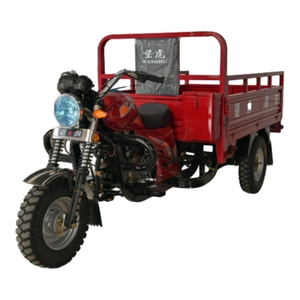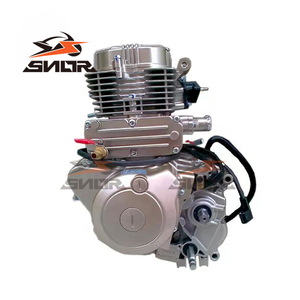Types of 150cc tricycle engine
A 150cc tricycle engine is a 150 cubic centimeter or 9.15-cubic-inch engine displacement. Usually, it indicates the size of the engine in the context of a motorized tricycle. The 150cc engine is a common choice for motorized tricycles, as it offers a balance of power and fuel efficiency. The 150cc tricycle engine can be classified into two main categories based on the cooling system: air-cooled and water-cooled.
- Air-cooled 150cc tricycle engine: The air-cooled 150cc tricycle engine relies on airflow to dissipate heat generated during engine operation. Typically, an air-cooled engine has external fins or cooling fins. The fins increase the surface area of the engine block and cylinder head. When the engine operates, the fins are cooled by the airflow generated by the vehicle's motion or by using a fan. The air-cooled 150cc tricycle engine has a simpler design, which means fewer components. As a result, the engine becomes more reliable with less maintenance. The engine is also lighter, which is an advantage for some tricycle designs. The air-cooled engine is particularly ideal for warmer climates. However, the engine can be less efficient in cooling when the tricycle is in motion at low speed or during high ambient temperatures.
- Water-cooled 150cc tricycle engine: The water-cooled 150cc tricycle engine uses water as a coolant to transfer heat away from the engine components. The coolant is circulated through the engine block and cylinder head by a water pump. Heat is then absorbed by the water and transferred to the radiator, where it is dissipated by airflow. The water-cooled 150cc tricycle engine can maintain consistent operating temperatures. It also offers better cooling efficiency, especially for high-load and high-speed operations. Water-cooled engines are generally more compact, and they can handle extreme ambient temperatures more effectively. However, the water-cooled 150cc tricycle engine requires a more complex cooling system, which can increase maintenance costs and overall engine weight.
Specification & Maintenance of 150cc Tricycle Engine
Trike motorcycles with 150cc engines are ideal for short rides and city commutes. The key specs of these engines show why they are so efficient and reliable:
- Engine Size: The 150cc engine is average-sized, making it powerful enough for most tasks without being too loud or using up a lot of gas.
- Power Output: 150cc engines usually put out between 10-15 horsepower. This is enough to get the trike moving steadily and keep a safe speed on the roads.
- Torque: Trikes generate about 9-12 lb-ft of torque from their 150cc engines. The torque helps accelerate the vehicle and pull loads if needed.
- Cylinder Configuration: Most 150cc engines have 1 or 2 cylinders. More cylinders mean a smoother ride, while fewer cylinders make the engine simpler and cheaper.
- Cooling System: 150cc tricycle engines are usually air-cooled. This is an easy way to keep the engine at the right temp without needing extra coolant parts.
- Fuel System: These engines use either carburetors or fuel injection to mix gas and air. Fuel injection gives better gas mileage and works well at different heights.
- Ignition System: 150cc engines have electric ignitions that spark the gas-air mix to start combustion.
- Transmission: The trike typically has an automatic transmission with a CVT (continuously variable transmission) or a manual transmission with a few gears.
- Starting System: Most 150cc trike engines use an electric starter to crank the engine. Some also have a kick starter as a backup.
- Fuel Type: Regular unleaded gasoline with an octane rating of 87 is required for 150cc trike engines. No special racing fuel is needed.
Despite their smaller size, 150cc trike engines have lots of cool tech under the hood. Key components include:
- Pistons: These move up and down in the cylinders to convert the combustion explosions into mechanical power.
- Crankshaft: The pistons are connected to this long shaft that converts their back-and-forth motion into spinning rotational power.
- Camshaft: This shaft controls the opening and closing of the engine's valves, which let air and fuel in and exhaust out.
- Valves: Each cylinder has 1 or 2 valves that regulate what goes in and out of the cylinder.
- Timing Belt or Chain: This keeps the camshaft in sync with the crankshaft so valves open and close at the right times.
- Fuel Tank: Gas is stored here until pumped to the engine for combustion.
- Exhaust System: This pipe carries the harmful exhaust gases out of the engine and away from the rider.
- Air Filter: Before reaching the engine, this filter cleans the air by trapping dirt and dust particles to avoid engine wear.
- Oil Filter: Like the air filter, this one ensures the engine oil is clean by filtering out impurities before lubricating the engine.
- Cooling fins: These let air flow over the engine to absorb heat and keep it from overheating.
With the right care, 150cc trike engine motorcycles can run well for many miles. Here are maintenance tips to keep them in top shape:
- Oil Changes: Change the engine oil every 2,000-3,000 miles or at least every 3-6 months. This keeps the engine parts well-lubricated and clean.
- Air Filter: Check and clean the air filter every 1,000 miles. Replace it completely after 10,000 miles or if damaged.
- Valves: Inspect the valves for proper spacing every 5,000 miles. Adjust as needed to maintain engine efficiency and power.
- Fuel System: Drain and replace the fuel every 6 months if not used. Add a fuel stabilizer to prevent degradation. Clean the fuel lines and filter to avoid clogs.
- Cooling System: Check the coolant level and top up as needed every 2,000 miles. Flush and replace the coolant completely after 20,000 miles.
- Electrical System: Inspect the battery, cables, and connections for damage or corrosion every 1,000 miles. Clean as needed and replace the battery after 2-3 years.
- Tires: Check tire pressure, tread depth, and overall condition every week. Rotate the tires after 5,000 miles or if uneven wear occurs.
- Brakes: Inspect the brake pads, discs, and calipers every 5,000 miles. Replace pads when worn and bleed the brakes every 10,000 miles for optimal stopping power.
- Suspension: Check the suspension fork seals and bushings for wear every 5,000 miles. Replace parts as needed to ensure a smooth ride.
- Chassis: Tighten all bolts and nuts on the frame, footpegs, and seat every 10,000 miles. Keep the chassis clean and free of rust or damage.
Following these simple tips will keep the 150cc engine running great and prolong the life of the trike.
How to choose 150cc tricycle engine
Before buying any 150cc Trike engine, business buyers need to understand the factors that affect the engine's quality. Here are some of them.
-
Branding
Some of the well-known brands of 150cc engine trike are reputable because they offer quality engines. The engines from reputable brands also have good performance and durability. When buying a 150cc engine trike, consider the brand to ensure that it matches the needs of the target customers.
-
Purpose
Business buyers should consider the purpose of the engine trike. Different customers buy the engine trike for various purposes. Some use it for commercial transportation, delivery services, or personal transportation. A 150cc engine trike suitable for one purpose may not be ideal for another. Therefore, consider the purpose to ensure that it fits the needs of the customer.
-
Load capacity
Different 150cc tricycle engines have different load capacities. Some have a load capacity of up to 300 kg, while others can carry a load of 400 kg. When buying a 150cc engine trike, consider the load capacity to ensure that it can carry the load without overstraining the engine.
-
Fuel efficiency
Different models of the 150cc engine use different amounts of fuel. Some models are more fuel efficient than others. When buying a 150cc engine trike, consider its fuel efficiency. The fuel-efficient engine trike will save the customers' money in the long run.
-
Warranty
Most manufacturers offer a warranty of up to 12 months for the 150cc engine trike. If the engine trike has a warranty, buyers can return or replace it in case of manufacturer defects within the specified period. Because the warranty protects the investment, buyers should consider it before buying the 150cc engine trike.
How to DIY and replace 150cc tricycle engines
Engine replacements can be pretty tricky. Fortunately, there are ways to replace a 150cc engine in a tricycle DIY-style. Before starting, it would be wise to consult the user manual for specific instructions regarding the model in question. Collect the following tools before starting the process:
- Socket set
- Wrench set
- Torque wrench
- Screwdrivers
- New engine oil
- Oil filter
- Air filter
- Cooling system (if applicable)
- Electrical wiring diagram (if applicable)
Once all the tools are set, follow these steps:
- Remove the seat and any other body parts covering the engine.
- Disconnect the battery.
- Drain any fluids, including gas.
- Follow the manufacturer's guide to disconnect the engine from the chassis.
- Lift the old engine out of the chassis with a hoist or an engine crane.
- Place the new engine onto the chassis and connect it according to the manufacturer's guide.
- Connect all the electrical components and cooling system.
- Replace the oil using the new oil filter.
- Inflate the cooling system with engine coolant.
- Reconnect the battery.
- Start the engine and let it run for a few minutes.
- Check for any leaks or unusual noises.
- Reinstall the bodywork and seat.
It's important to note that this is a general guide and the process may vary depending on the specific model and engine configuration. Always refer to the manufacturer's manual for detailed instructions.
Q and A
Q1: Are 150cc tricycle engines good?
A1: The 150cc engine is good and widely used. It gives enough power to move the tricycle and its passengers or cargo. However, whether it is good or not depends on various factors, such as the terrain, the tricycle model, and the load capacity.
Q2: How fast can a 150cc tricycle engine go?
A2: Generally, a 150cc engine can reach speeds of 60 to 70 mph. However, the speed also depends on the tricycle design, the road condition, and the load it carries.
Q3: Can a 150cc engine be upgraded for better performance?
A3: Yes, a 150cc engine can be upgraded. Changing the air intake system and exhaust can boost engine performance. Reprogramming or replacing the engine control unit can also improve performance. However, it's important to consult with a mechanic or engine expert before making any upgrades.























































































































































































































